Bulk Scaling Model of Entrainment Zone Thickness in a Convective Boundary Layer, with a Shear Effect Promoted by Velocity Difference
Abstract
1. Introduction
2. Numerical Methodology
2.1. LES Description
2.2. Large-Eddy Simulation Setup
2.3. Initial Conditions and Data Post-Processing
3. Evaluation of the Existing Bulk Models
3.1. Thickness of the Entrainment Zone
3.2. Evaluation of the Existing Bulk Models
4. Improved Bulk Scaling Models in a Sheared Convective Boundary Layer
4.1. Development of the Improved Bulk Scaling Model
4.2. Comparison of the Improved Model Against the Available Data
5. Conclusions
- The traditional model does not include the shear effect on entrainment, and thus does not perform well in the sheared CBL. Using as the velocity scale to include the shear effect on entrainment, the revised model provides some improvement in the predictions, but still with large deviations due to the large deviations in determining in the entrainment zone.
- For the correlation with , is adopted as the influence factor of inversion stratification on entrainment process in the model, which reduces the deviations of the predictions. However, this model is mainly aimed at a shear-free CBL, and also fails to take into account of the shear effect.
- In the model, the entrainment velocity at the interface is used as the velocity scale, which implicitly involves the comprehensive influence of buoyancy and shear on the entrainment process. However, each influence factor on the process cannot be quantified clearly, and the predictions are not very accurate.
- Similarly, due to the exclusion of the shear effect on entrainment, the “” model also has some limitations in the predictions for sheared CBL.
Author Contributions
Funding
Acknowledgments
Conflicts of Interest
References
- Ackerman, A.S.; Kirkpatrick, M.P.; Stevens, D.E.; Toon, O.B. The impact of humidity above stratiform clouds on indirect aerosol climate forcing. Nature 2004, 432, 1014–1017. [Google Scholar] [CrossRef]
- IPCC. Climate Change 2007: The Physical Science Basis. In Contribution of Working Group I to the Fourth Assessment Report of the Intergovernmental Panel on Climate Change; Cambridge University Press: Cambridge, UK; New York, NY, USA, 2007; p. 996. [Google Scholar]
- Conzemius, R.J.; Fedorovich, E. Dynamics of sheared convective boundary layer entrainment. Part I: Methodological background and large-eddy simulations. J. Atmos. Sci. 2006, 63, 1151–1178. [Google Scholar] [CrossRef]
- Conzemius, R.J.; Fedorovich, E. Dynamics of sheared convective boundary layer entrainment. Part II: Evaluation of bulk model predictions of entrainment flux. J. Atmos. Sci. 2006, 63, 1179–1199. [Google Scholar] [CrossRef][Green Version]
- Lilly, D.K. Models of cloud-topped mixed layers under a strong inversion. Q. J. R. Meteorol. Soc. 1968, 94, 292–309. [Google Scholar] [CrossRef]
- Betts, A.K. Non-precipitating cumulus convection and its parameterization. Q. J. R. Meteorol. Soc. 1973, 99, 178–196. [Google Scholar] [CrossRef]
- Fedorovich, E.; Conzemius, R.; Mironov, D. Convective entrainment into a shear-Free, linearly stratified atmosphere: Bulk models reevaluated through large eddy simulations. J. Atmos. Sci. 2004, 61, 281–295. [Google Scholar] [CrossRef]
- Turner, J.S.; Benton, E.R. Buoyancy Effects in Fluids. Phys. Today 1974, 27, 52–53. [Google Scholar] [CrossRef]
- Vanzanten, M.C.; Duynkerke, P.G.; Cuijpers, J.W.M. Entrainment parameterization in convective boundary Layers. J. Atmos. Sci. 1999, 56, 813–828. [Google Scholar] [CrossRef]
- Stull, R.B. Inversion rise model based on penetrative convection. J. Atmos. Sci. 1973, 30, 1092–1099. [Google Scholar] [CrossRef]
- Zeman, O.; Tennekes, H. Parameterization of the turbulent energy budget at the top of the daytime atmospheric boundary layer. J. Atmos. Sci. 1977, 34, 111–123. [Google Scholar] [CrossRef]
- Deardorff, J.W.; Willis, G.E.; Stockton, B.H. Laboratory studies of the entrainment zone of a convectively mixed layer. J. Fluid. Mech. 1980, 100, 41–64. [Google Scholar] [CrossRef]
- Boers, R. A parameterization of the depth of the entrainment zone. J. Appl. Meteorol. 1989, 28, 107–111. [Google Scholar] [CrossRef][Green Version]
- Beyrich, F.; Gryning, S.E. Estimation of the entrainment zone depth in a shallow convective boundary layer from sodar data. J. Appl. Meteorol. 1998, 37, 255–268. [Google Scholar] [CrossRef]
- Gryning, S.E.; Batchavarova, E. Parameterization of the depth of the entrainment zone above the daytime mixed layer. Q. J. R. Meteorol. Soc. 1994, 120, 47–58. [Google Scholar] [CrossRef]
- Boers, R.; Eloranta, E.W. Lidar measurements of the atmospheric entrainment zone and the potential temperature jump across the top of the mixed layer. Bound. Layer Meteorol. 1986, 34, 357–375. [Google Scholar] [CrossRef]
- Kim, S.W.; Park, S.U.; Pino, D.; Arellano, J.V.G. Parameterization of entrainment in a sheared convective boundary layer using a first-order jump model. Bound. Layer Meteorol. 2006, 120, 455–475. [Google Scholar] [CrossRef][Green Version]
- Heng, L.; Jian-Ning, S.; Wei, L. Parameterization of the entrainment zone depth above the sheared convective boundary layer derived from large-eddy simulations. J. Nanjing Univ. (Nat. Sci.) 2010, 46, 616–623. (In Chinese) [Google Scholar] [CrossRef]
- Hageli, P.; Steyn, D.G.; Strawbridge, K.B. Spatial and temporal variability of mixed-layer depth and entrainment zone thickness. Bound. Layer Meteorol. 2000, 97, 47–71. [Google Scholar] [CrossRef]
- Jianning, S.; Weimei, J.; Ziyun, C.; Renmin, Y. Parameterization for the depth of the entrainment zone above the convectively mixed layer. Adv. Atmos. Sci. 2005, 22, 114–121. [Google Scholar] [CrossRef]
- Boers, R.; Eloranta, E.W.; Coulter, R.L. Lidar observations of mixed layer dynamics: Tests of parameterized entrainment models of mixed layer growth rate. J. Clim. Appl. Meteorol. 1984, 23, 247–266. [Google Scholar] [CrossRef]
- Lewellen, D.C.; Lewellen, W.S. Large-eddy boundary layer entrainment. J. Atmos. Sci. 1998, 55, 2645–2665. [Google Scholar] [CrossRef]
- Conzemius, R.J.; Fedorovich, E. Bulk models of the sheared convective boundary: Valuation through large-eddy simulations. J. Atmos. Sci. 2007, 64, 786–807. [Google Scholar] [CrossRef]
- Lilly, D.K. A proposed modification of the Germano subgrid-scale closure method. Phys. Fluids 1992, 4, 633–635. [Google Scholar] [CrossRef]
- Fureby, C.; Tabor, G.; Weller, H.G. A comparative study of subgrid scale models in homogeneous isotropic turbulence. Phys. Fluids 1997, 9, 1416–1429. [Google Scholar] [CrossRef]
- Garcia, J.R.; Mellado, J.P. The Two-Layer Structure of the Entrainment Zone in the Convective Boundary Layer. J. Atmos. Sci. 2014, 71, 1935–1955. [Google Scholar] [CrossRef]
- Mellado, J.P.; Bretherton, C.S.; Stevens, B.; Wyant, M.C. DNS and LES for simulating stratocumulus: Better together. J. Adv. Model. Earth Syst. 2018, 10, 1421–1438. [Google Scholar] [CrossRef]
- Germano, M.; Piomelli, U.; Moin, P.; Cabot, W.H. A dynamic subgrid-scale eddy viscosity model. Phys. Fluids 1991, 3, 1760–1765. [Google Scholar] [CrossRef]
- Fitzjarrald, D.E. Horizontal scales of motion in atmospheric free convection observed during the GATE experiment. J. Appl. Meteorol. 1978, 17, 213–221. [Google Scholar] [CrossRef][Green Version]
- Hadfield, M.G.; Cotton, W.R.; Pielke, R.A. Large-eddy simulations of thermally forced circulations in the convective boundary layer. Part II: The effects of changes in wavelength and wind speed. Bound. Layer Meteorol. 1991, 58, 307–327. [Google Scholar] [CrossRef]
- Dörnbrack, A.; Schumann, U. Numerical simulation of turbulent convective flow over wavy terrain. Bound. Layer Meteorol. 1993, 65, 323–355. [Google Scholar] [CrossRef]
- Sullivan, P.P.; Moeng, C.H.; Stevens, B.; Lenschow, D.H.; Mayor, S.D. Structure of the entrainment zone capping the convective atmospheric boundary layer. J. Atmos. Sci. 1998, 55, 3042–3064. [Google Scholar] [CrossRef]
- Gentine, P.; Ballon, G.; Heerwaarden, C.C.V. A closer look at boundary layer inversion in large-eddy simulations and bulk models: Buoyancy-driven case. J. Atmos. Sci. 2015, 72, 728–749. [Google Scholar] [CrossRef]
- Lssa, R.; Befrui, B.; Beshay, K.R.; Gosman, A.D. Solution of the implicitly discretized reacting flow equations by operator-splitting. J. Compt. Phys. 1991, 93, 388–410. [Google Scholar] [CrossRef]
- Xuhui, C.; Jiayi, C. Large eddy simulation of bubble-like structures in the convective boundary layer. Chin. J. Atmos. Sci. 1997, 21, 223–230. (In Chinese) [Google Scholar] [CrossRef]
- Hibberd, M.F.; Sawford, B.L. Design criteria for water tank models of dispersion in the planetary boundary layer. Bound. Layer Meteorol. 1994, 67, 97–118. [Google Scholar] [CrossRef]
- Fedorovich, E.; Mironov, D.V. A model for a shear-free convective boundary layer with parameterized capping inversion structure. J. Atmos. Sci. 1995, 52, 83–96. [Google Scholar] [CrossRef][Green Version]
- Pino, D.; Vlilà-Guerau de Arellano, J.; Duynkerke, P.G. The contribution of shear to the evolution of a convective boundary layer. J. Atmos. Sci. 2003, 60, 1913–1926. [Google Scholar] [CrossRef]
- Deardorff, J.W.; Willis, G.E. Dependence of mixed-layer entrainment on shear stress and velocity jump. J. Fluid Mech. 1982, 115, 123–140. [Google Scholar] [CrossRef]
- Moeng, C.H.; Sullivan, P.P. A comparison of shear- and buoyancy-driven planetary boundary layer flows. J. Atmos. Sci. 1994, 51, 999–1022. [Google Scholar] [CrossRef]
- Otte, M.J.; Wyngaard, J.C. Stably stratified interfacial-layer turbulence from large-eddy simulation. J. Atmos. Sci. 2001, 58, 3424–3442. [Google Scholar] [CrossRef]
- Lothon, M.; Lenschow, D.H.; Mayor, S. Measurements of turbulence structure in the daytime convective boundary layer from a ground-based doppler lidar. In Proceedings of the 18th Symposium on Boundary Layers and Turbulence, Stockholm, Sweden, 9–13 June 2008. [Google Scholar]
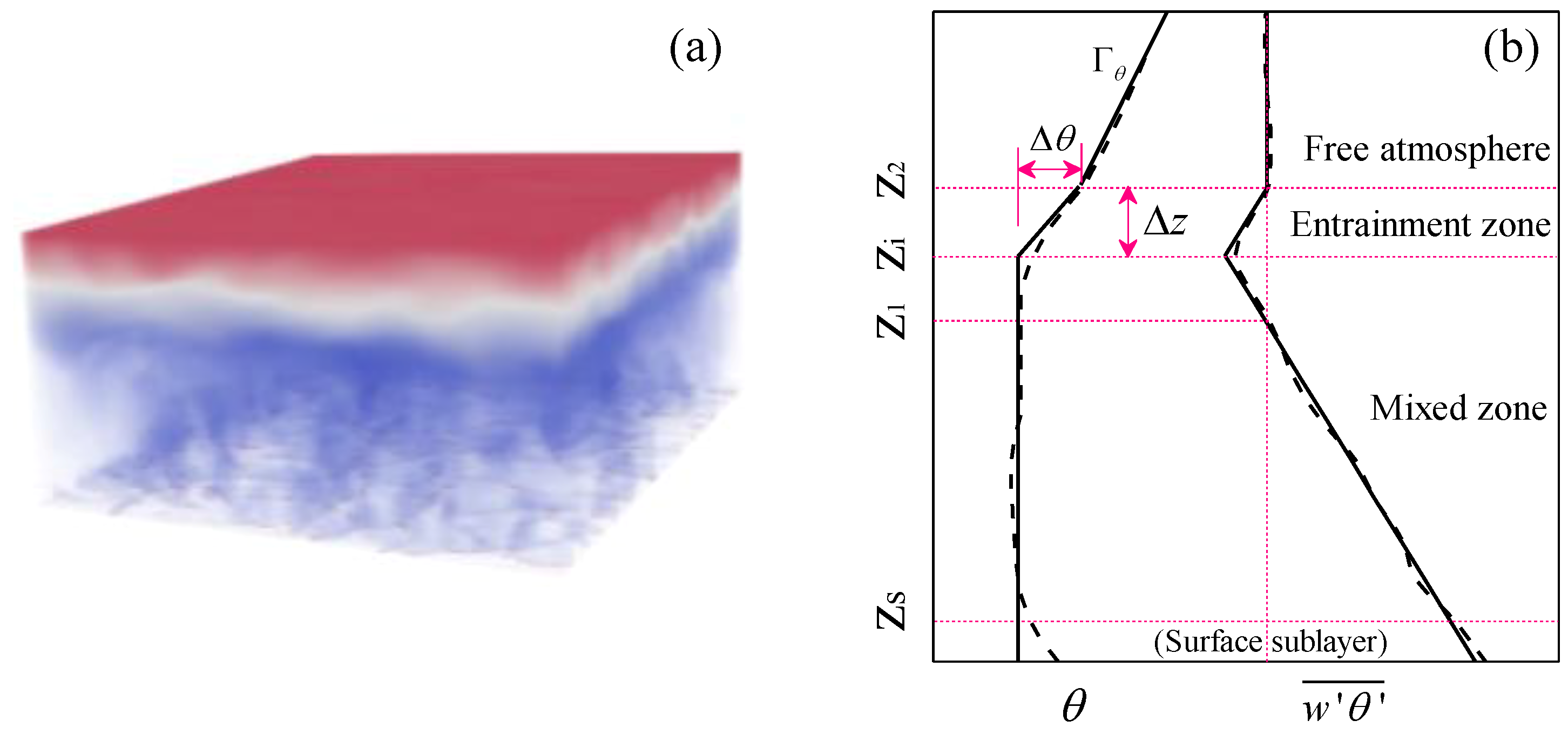
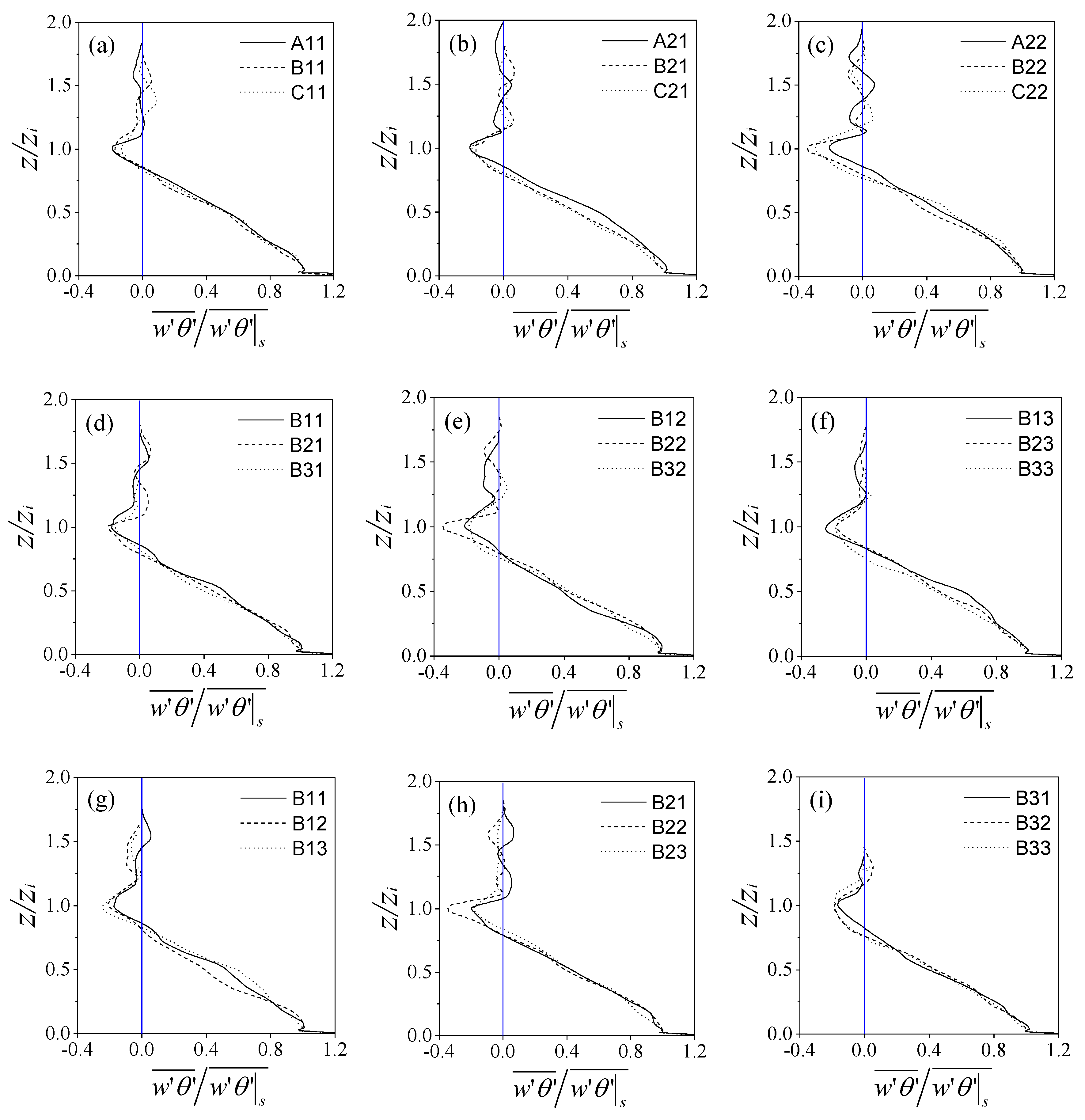
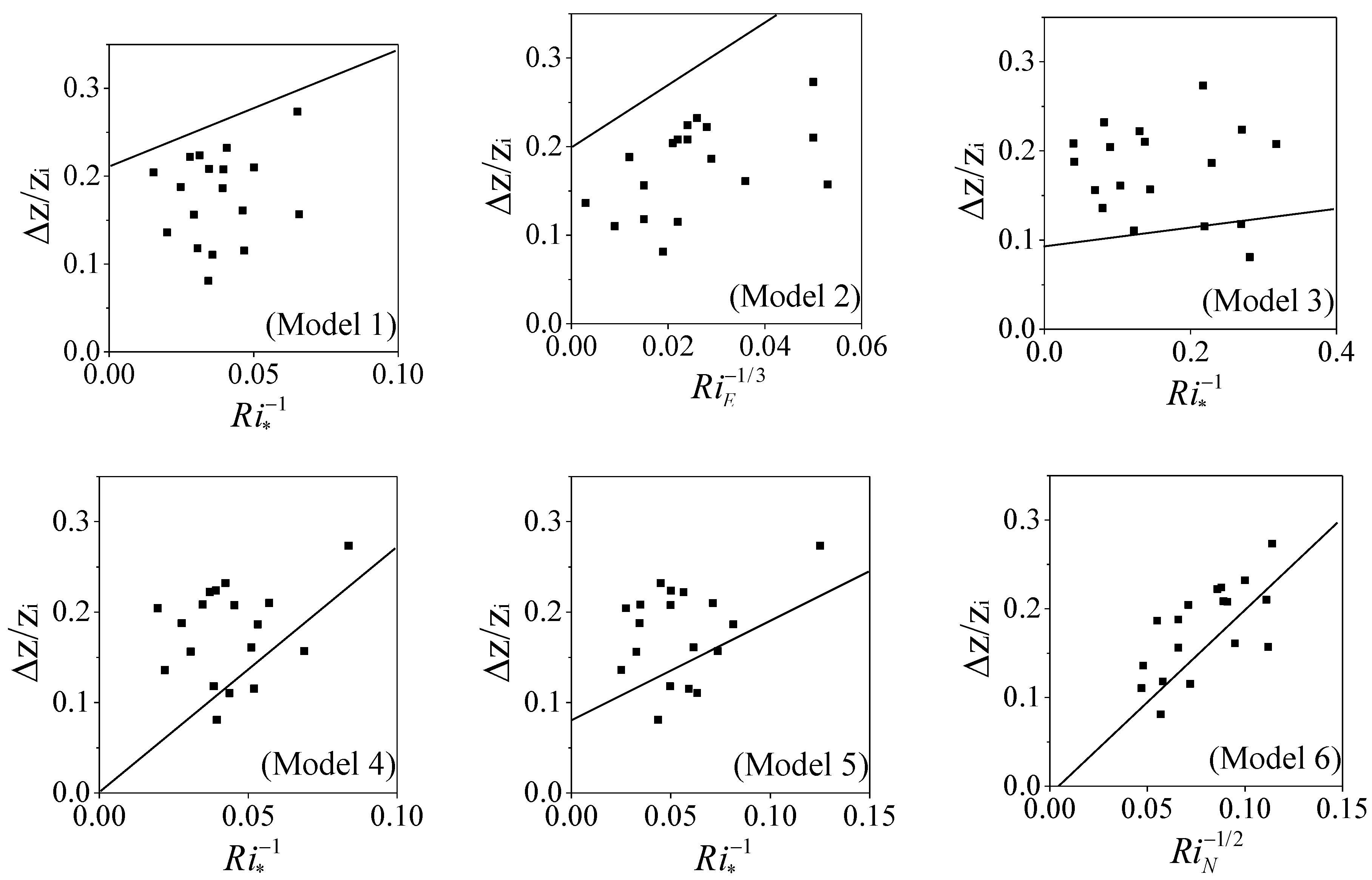

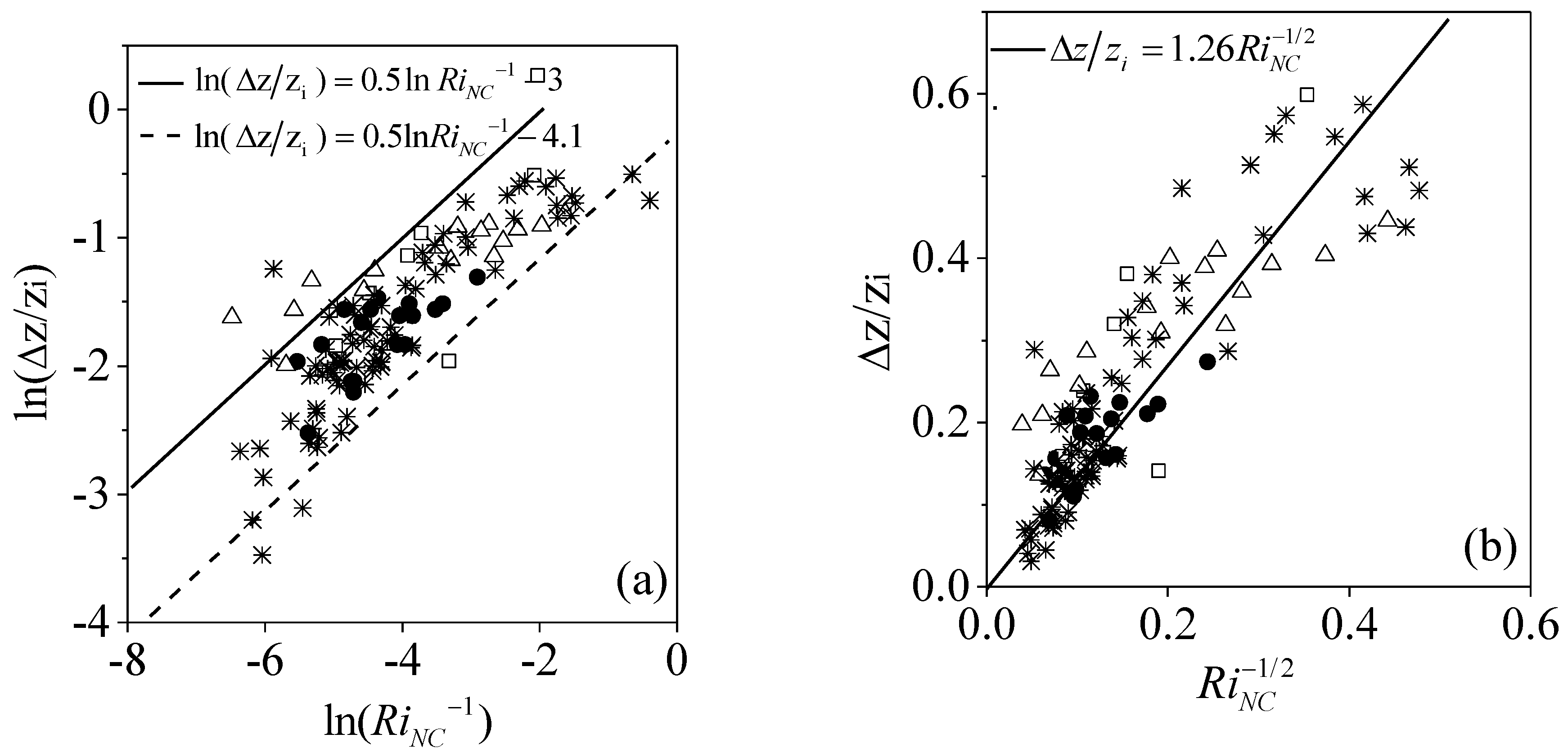
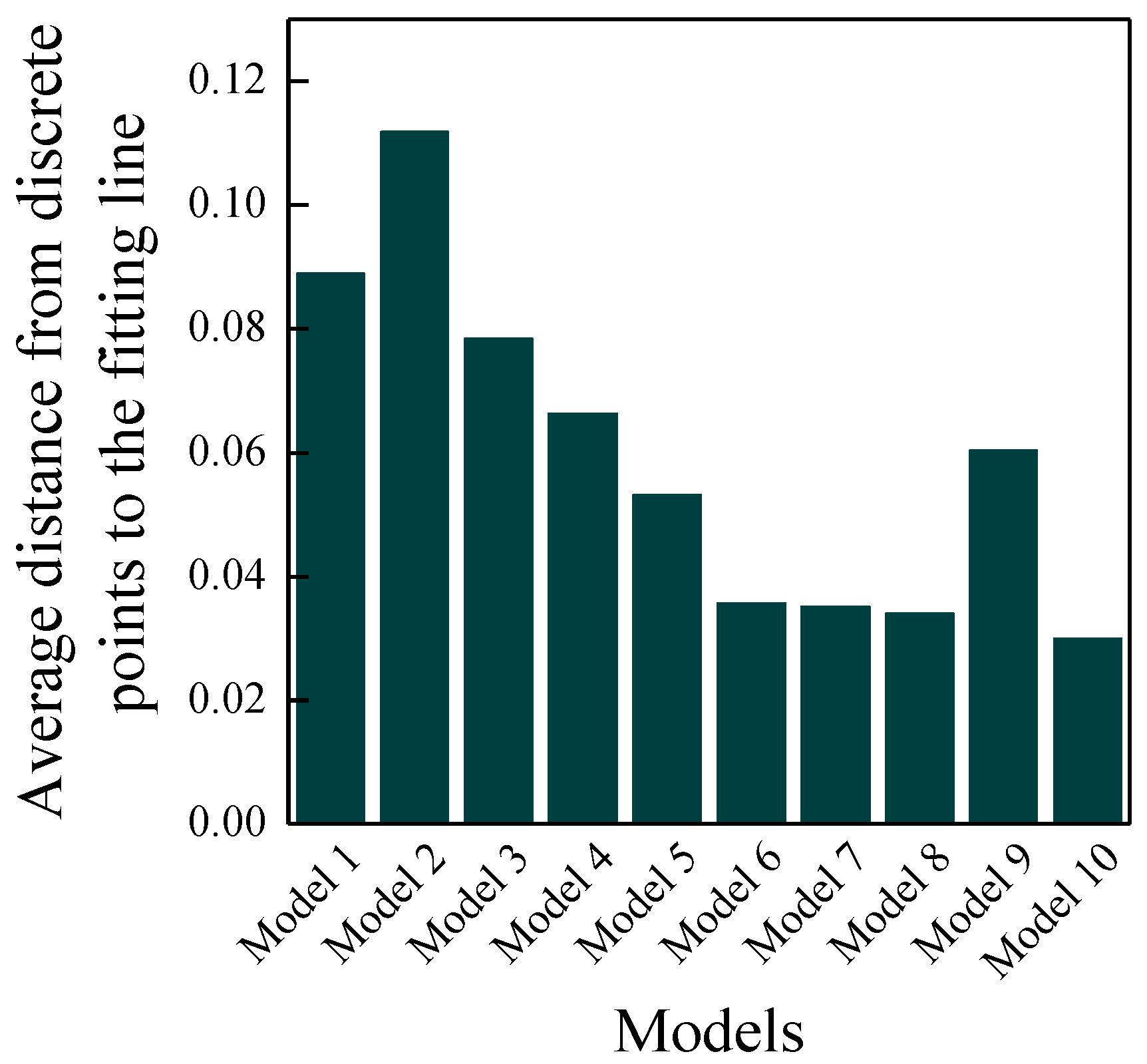
| △U = 0 m/s | △U = 1.5 m/s | △U = 3 m/s | △U = 4.5 m/s | △U = 1.5 m/s | △U = 3 m/s | △U = 4.5 m/s | △U = 1.5 m/s | △U = 3 m/s | △U = 4.5 m/s | |
|---|---|---|---|---|---|---|---|---|---|---|
| 0.05 | A11 | A12 | A21 | A22 | ||||||
| 0.1 | B10 | B11 | B12 | B13 | B21 | B22 | B23 | B31 | B32 | B33 |
| 0.15 | C11 | C12 | C21 | C22 | ||||||
| Convective System | U m/s | Pr | Re × 108 | Raf × 1022 | ||||
|---|---|---|---|---|---|---|---|---|
| Field observation | 0–10 | 0.0003–0.03 | 0.03–0.3 | 500–2500 | 0.8–3.0 | ~0.71 | 0.3–5 | 1–7000 |
| LES cases of this study | 3–7.5 | 0.003–0.015 | 0.05–0.15 | 1000–1300 | 1.2–1.7 | ~0.71 | 0.21–5.1 | 25–80 |
© 2020 by the authors. Licensee MDPI, Basel, Switzerland. This article is an open access article distributed under the terms and conditions of the Creative Commons Attribution (CC BY) license (http://creativecommons.org/licenses/by/4.0/).
Share and Cite
Li, A.; Gao, W.; Liu, T. Bulk Scaling Model of Entrainment Zone Thickness in a Convective Boundary Layer, with a Shear Effect Promoted by Velocity Difference. Atmosphere 2020, 11, 63. https://doi.org/10.3390/atmos11010063
Li A, Gao W, Liu T. Bulk Scaling Model of Entrainment Zone Thickness in a Convective Boundary Layer, with a Shear Effect Promoted by Velocity Difference. Atmosphere. 2020; 11(1):63. https://doi.org/10.3390/atmos11010063
Chicago/Turabian StyleLi, Anran, Wenfeng Gao, and Tao Liu. 2020. "Bulk Scaling Model of Entrainment Zone Thickness in a Convective Boundary Layer, with a Shear Effect Promoted by Velocity Difference" Atmosphere 11, no. 1: 63. https://doi.org/10.3390/atmos11010063
APA StyleLi, A., Gao, W., & Liu, T. (2020). Bulk Scaling Model of Entrainment Zone Thickness in a Convective Boundary Layer, with a Shear Effect Promoted by Velocity Difference. Atmosphere, 11(1), 63. https://doi.org/10.3390/atmos11010063





